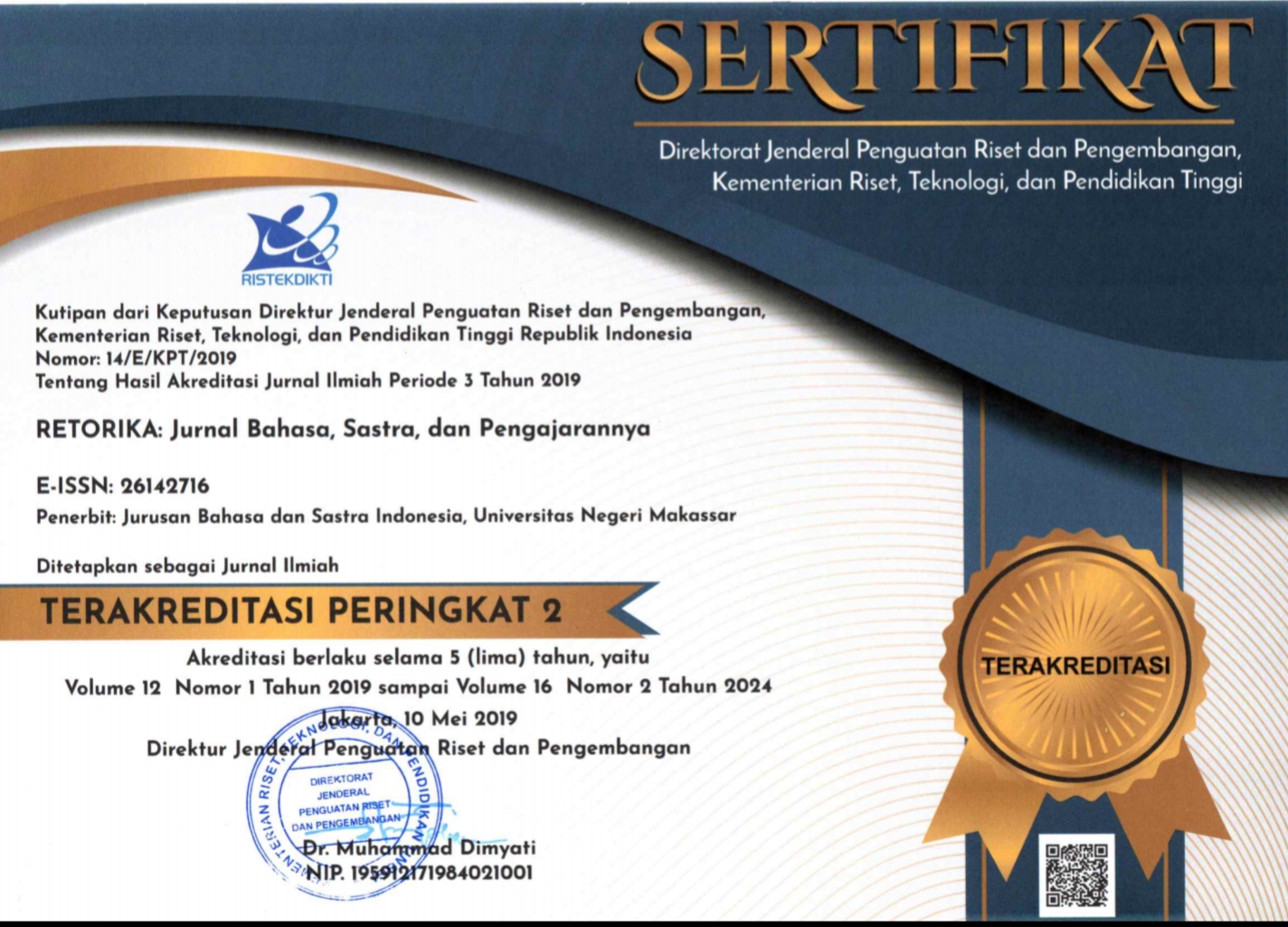THE IDIOMATIC CONSTRUCTIONS OF ”BAPAK” IN BAHASA INDONESIA
(1) Sanata Dharma University
(*) Corresponding Author
DOI: https://doi.org/10.26858/retorika.v13i2.13099
Abstract
This research aimed to describe the idiomatic constructions of lexeme of BAPAK in Bahasa Indonesia (BI). The language description method used in this study was adopted from the semantic analysis model suggested by Langlotz (2006). The sources of the data were the corpus websites that provided the BI data-set. Observation was used to collect the data and a distributional technique was used to analyze the data. The results of the analysis described that the idiomatic constructions of lexeme of BAPAK had two patterns of constructions and three types of proposition that were embedded in them. Thus, it can be inferred that the idiomatic constructions of BAPAK can be described through their structural patterns and types of proposition.
Keywords
Full Text:
PDFReferences
Al-Khawaldeh, N., Jaradat, A., Al-momani, H., & Bani-Khair, B. (2016). Figurative Idiomatic Language: Strategies and Difficulties of Un-derstanding English Idioms. International Journal of Applied Linguistics and English Literature, 5 (6): 119–325 https://doi.org/ 10. 7575/aiac.ija lel.v.5n.6p.119
Almohizea, M. I. (2016). The Placement of Idioms in Traditional and Non-Traditional Approaches. International Journal of Language and Lingu-istics, 3 (5): 10.
Boulenger, V., Hauk, O., & Pulvermuller, F. (2009). Grasping Ideas with the Motor System: Se-mantic Somatotopy in Idiom Comprehen-sion. Cerebral Cortex, 19 (8): 1905–1914. https://doi. org/10.1093/cercor/bhn217
Cacciari, C. (2014). Processing multiword idiomatic strings: Many words in one? The Mental Lexi-con, 9 (2): 267–293. https://doi.org/10. 1075/ml.9.2.05cac
Cacciari, C., & Levorato, M. C. (1998). The Effect of Semantic Analyzability of Idioms in Met-alinguistic Tasks. Metaphor and Symbol, 13 (3): 159–177. https://doi.org/10.1207/s15327868 ms1303_1
Caillies, S., & Butcher, K. (2007). Processing of Idiomatic Expressions: Evidence for a New Hybrid View. Metaphor and Symbol, 22 (1): 79–108. https://doi.org/10.1080/10926480709 336754
Carston, R. (2018). Figurative Language, Mental Imagery, and Pragmatics. Metaphor and Sym-bol, 33 (3): 198–217. https://doi.org/10. 1080/ 1092 6488.2018.1481257
Cermak, F. (2001). SUBSTANCE OF IDIOMS: PERENNIAL PROBLEMS, LACK OF DA-TA OR THEORY? International Journal of Lexicography, 14 (1): 1–20. https://doi.org/10. 1093/ ijl/ 14.1.1
Ellis, N. C. (2008). Words and their usage: Commen-tary on the special issue on the bi-lingual mental lexicon. The Mental Lexicon, 3 (3): 375–385. https://doi.org/10.1075/ml.3.3.07ell
Elman, J. L. (2011). Lexical knowledge without a lexicon? The Mental Lexicon, 6 (1): 1–33. https://doi.org/10.1075/ml.6.1.01elm
Findlay, H., & Carrol, G. (2018). Contributions of semantic richness to the processing of idioms. The Mental Lexicon, 13 (3): 311–332. https://doi.org/10.1075/ml.18014.fin
Gillon, B. (2009). Introduction to “The syntax–semantics interface and the origins of philoso-phy.” The Mental Lexicon, 4 (1): 147–148. https://doi.org/10.1075/ml.4.1.06gil
Gogichev, C. (2016). Two categorization patterns in idiom semantics. Pragmatics & Cognition, 23 (2): 343–358. https://doi.org/10.1075/pc.23. 2.08gor
Hanks, P. (2004). THE SYNTAGMATICS OF METAPHOR AND IDIOM. International Journal of Lexicography, 17 (3): 245–274. https://doi. org/10.1093/ijl/17.3.245
Hyun, J., Conner, P. S., & Obler, L. K. (2014). Idi-om properties influencing idiom production in younger and older adults. The Mental Lexicon, 9 (2): 294–315. https://doi.org/10.1075/ml.9.2. 06hyu
Ibáñez, F. J. R. de M., & Lozano-Palacio, I. (2019). A Cognitive-Linguistic Approach to Complex-ity in Irony: Dissecting the Ironic Echo. Meta-phor and Symbol, 34(2): 127–138. https://doi.org/10. 1080/10926488.2019.1611714
Isodarus, P. (2017). IDIOMS CONTAINING THE WORD HATI AND TRANSITIVE VERBS IN INDONESIAN LANGUAGE. International Journal of Humanity Studies, 1 (1): 71–83. https://doi.org/10.24071/ijhs.2017.010108
Jackendoff, R., & Audring, J. (2016). Morphological schemas: Theoretical and psycholinguistic is-sues. The Mental Lexicon, 11 (3): 467–493. https://doi.org/10.1075/ml.11.3.06jac
Järvikivi, J., Pyykkönen-Klauck, P., & Laine, M. (2014). Introduction: Words & constructions: Language complexity in linguistics and psy-chology. The Mental Lexicon, 9 (2): 141–143. https://doi.org/10.1075/ml.9.2.00jar
Karlsson, F. (2014). Complexity in linguistic theo-rizing. The Mental Lexicon, 9 (2): 144–169. https://doi.org/10.1075/ml.9.2.01kar
Kay, P., Berkeley, U. C., & Sag, I. A. (2014). A Lexical Theory of Phrasal Idioms. Stanford University.
Khak’, M. A. (2011). IDIOM DALAM BAHASA INDONESIA: STRUKTUR DAN MAKNAI.). WIDYAPARWA, 39 (2): 141–154.
Lakoff, G. (1986). A Figure of Thought. Metaphor and Symbolic Activity, 1 (3): 215–225. https://doi. org/10.1207/s15327868ms0103_4
Lambek, J. (2009). The syntax–semantics interface and the origins of philosophy. The Mental Lexicon, 4 (1): 149–156. https://doi.org/10.1075/ ml.4.1.07lam
Langlotz, A. (2006). Idiomatic creativity: A cogni-tive-linguistic model of idiom-representation and idiom-variation in English. Amsterdam; Philadelphia: J. Benjamins.
Laurent, J.-P., Denhières, G., Passerieux, C., Iaki-mova, G., & Hardy-Baylé, M.-C. (2006). On understanding idiomatic language: The sali-ence hypothesis assessed by ERPs. Brain Re-search, 1068 (1): 151–160. https://doi.org/10. 1016/j.brainres.2005.10.076
Li, L., & Sporleder, C. (2009). Classifier combina-tion for contextual idiom detection without la-belled data. Proceedings of the 2009 Confer-ence on Empirical Methods in Natural Lan-guage Processing Volume 1 - EMNLP ’09, 1, 315–323. https://doi.org/10.3115/1699510.1699552
Liang, Y., & Pascual, E. (2019). Mixed metaphors: Their use and abuse. Metaphor and Symbol, 34 (2): 139–140. https://doi.org/10.1080/1092648 8.2019.1611716
Liu, Z. (2012). Analysis of Idiom Variation in the Framework of Linguistic Subjectivity. English Language Teaching, 5 (6): 105. https://doi.org/ 10.5539/elt.v5n6p105
Nenonen, M., Niemi, J., & Laine, M. (2002). Repre-sentation and processing of idioms: Evidence from aphasia. Journal of Neurolinguistics, 15 (1): 43–58. https://doi.org/10.1016/S0911-60 44(01)00005-7
Nugraha, D. S. (2016). Perluasan Makna Leksem Anak dalam Bahasa Indonesia. Sirok Bastra, 4 (1): 7–16.
Nugraha, D. S. (2018). PERLUASAN LEKSEM IBU DALAM BAHASA INDONESIA: TIN-JAU-AN SEMANTIK. Prosiding Seminar Nasional Pertemuan Ilmiah Bahasa dan Sas-tra Indonesia XL, 661–672. Pekalongan: Unikal Press.
Peng, J., Feldman, A., & Vylomova, E. (2018). Classifying Idiomatic and Literal Expressions Using Topic Models and Intensity of Emo-tions. ArXiv:1802.09961[Cs]. Retrieved from http:// arxiv.org/abs/1802.09961
Potts, A., & Semino, E. (2019). Cancer as a Meta-phor. Metaphor and Symbol, 34 (2): 81–95. https:// doi.org/10.1080/10926488.2019.1611723
Richie, R. (2016). Functionalism in the lexicon: Where is it, and how did it get there? The Mental Lexicon, 11 (3): 429–466. https://doi.org/10.10 75/ml.11.3.05ric
Skoufaki, S. (2008). Investigating the Source of Idi-om Transparency Intuitions. Metaphor and Symbol, 24 (1): 20–41. https://doi.org/10.1080/ 10926480802568448
Spalding, T. L., & Gagn, C. L. (2007). Semantic property activation during the interpretation of combined concepts. The Mental Lexicon, 2 (1): 25–47.
Sudaryanto. (2015). Metode dan Aneka Teknik Ana-lisis Bahasa: Pengantar Penelitian Wahana Kebudayaan secara Linguistis. Yogyakarta: Sanata Dharma University Press.
Szczepaniak, R., & Lew, R. (2011). The Role of Imagery in Dictionaries of Idioms. Applied Linguistics, 32 (3): 323–347. https://doi.org/10. 1093/applin/amr001
Tabossi, P., Fanari, R., & Wolf, K. (2009). Why are idioms recognized fast? Memory & Cognition, 37 (4): 529–540. https://doi.org/10.3758/MC. 37.4.529
Turvey, M. T., & Moreno, M. A. (2006). Physical metaphors for the mental lexicon. The Mental Lexicon, 1 (1): 7–33. https://doi.org/10.1075/ml. 1.1.04tur
Widdows, D., & Dorow, B. (2005). Automatic ex-traction of idioms using graph analysis and asymmetric lexicosyntactic patterns. Proceed-ings of the ACL-SIGLEX Workshop on Deep Lexical Acquisition - DeepLA ’05: 48–56. https://doi. org/10.3115/1631850.1631856
Wilkosz, S. (2015). A comparative analysis of Polish and English idioms containing words from bird class. Studia Anglica Resoviensia, 12: 109–124. https://doi.org/10.15584/sar.2015.12.10
Yu, N., & Huang, J. (2019). Primary Metaphors across Languages: Difficulty as Weight and Solidity. Metaphor and Symbol, 34 (2): 111–126. https:// doi.org/10.1080/10926488.2019.1611725
Yusifova, G. I. (2013). Syntactic Features of English Idioms. International Journal of English Lin-guistics, 3 (3): p133. https://doi.org/10.5539/ ijel.v3n3p133
Article Metrics
Abstract view : 561 times | PDF view : 57 timesRefbacks
- There are currently no refbacks.
Copyright (c) 2020 Danang Satria Nugraha

This work is licensed under a Creative Commons Attribution-NonCommercial 4.0 International License.
Published by:
Department of Indonesian Language, Faculty of Languages and Literature, Universitas Negeri Makassar in cooperate with Asosiasi Dosen Bahasa dan Sastra Indonesia (ADOBSI) and Ikatan Program Studi Pendidikan Bahasa dan Sastra Indonesia (IKAPROBSI).
Address: Department of Indonesian Language Office, DG Building Second Floor, UNM Parangtambung, Daeng Tata Raya Street, Makassar, South Sulawesi, Indonesia
 Email: retorika@unm.ac.id
Email: retorika@unm.ac.id

RETORIKA: Jurnal Bahasa, Sastra,dan Pengajarannya is licensed under a Creative Commons Attribution-NonCommercial 4.0 International License.
















